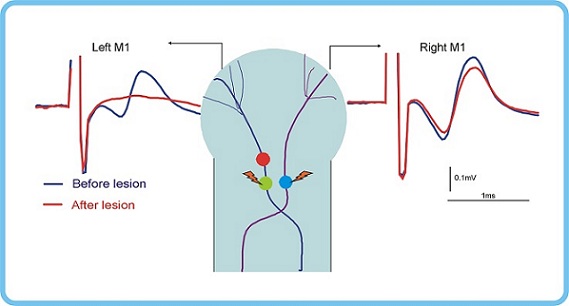Reticulospinal Tract
In primates, the corticospinal tract is the dominant pathway for control of movement, and has been much investigated. By contrast, pathways originating in the brainstem are often considered less important, and assumed to have a role primarily in posture or gross movements such as locomotion.
Recently, we have accumulated evidence that – in primates – the medial brainstem pathways (including vestibulospinal and reticulospinal tracts) may be involved in control of the distal muscles of the forelimb which are used in hand movements.
- Medial brainstem pathways can generate EPSPs in forearm motoneurons, over both mono- and di-synaptic pathways. This includes motoneurons projecting to intrinsic hand muscles. (Riddle CN, Edgley SA and Baker SN. 2009 - Direct and indirect connections with upper limb motoneurons from the primate reticulospinal tract)
- Interneurons in the intermediate zone of the spinal cord receive largely converging input from the corticospinal and medial brainstem pathways. This includes interneurons likely to be involved in hand movements. (Riddle, C.N. and Baker, S.N. 2010 - Convergence of pyramidal and medial brain stem descending pathways onto macaque cervical spinal interneurons.)
- Neurons in the reticular formation modulate their discharge whilst animals perform finely controlled finger movements (work submitted for publication).
Why does this matter? Lesions such as stroke or spinal cord injury often affect the corticospinal tract. Patients initially are paralyzed on the side of the lesion, but then they recover function. We hypothesise that part of this recovery stems from strengthening the reticulospinal connections which already exist, and which provide a parallel pathway for hand control.
We are currently investigating the contribution of the reticulospinal tract to functional recovery by making experimental lesions of the corticospinal tract on one side (see figure). Although initially paralysed, animals rapidly recover function on the side contralateral to the lesion. After 6-8 months, we then assess the strength of reticulospinal connections. Our preliminary data shows that reticulospinal connections do appear to strengthen. However, this occurs only for motoneurons projecting to forearm flexor and intrinsic hand muscles. This suggests that the reticulospinal tract may underlie much of the functional recovery that is seen. The selective strengthening of connections to flexors, and failure to enhance activation of extensors, may underlie the extensor weakness and flexor spasticity which often form the main characteristics of disability in a stroke survivor in the chronically recovered phase.

People involved in this project
- Dr Boubker Zaaimi (Post-doc)
- Dr Demetris Soteropoulos (Post-doc)
- Dr Nicholas Riddle
- Prof Stuart Baker (Supervisor)
Publications Relevant to this Project
- Riddle, C.N., Edgley, S.A. and Baker, S.N. (2009) Direct and indirect connections with upper limb motoneurons from the primate reticulospinal tract. J Neurosci 29, 4993-4999.
- Riddle, C.N. and Baker, S.N. (2010) Convergence of pyramidal and medial brain stem descending pathways onto macaque cervical spinal interneurons. Journal of Neurophysiology 103, 2821-2832.
Sponsors of this study
Back to the Projects


